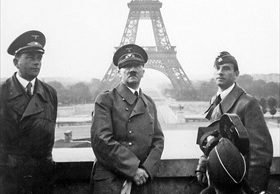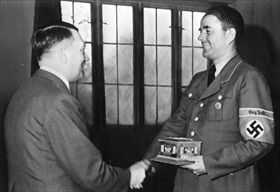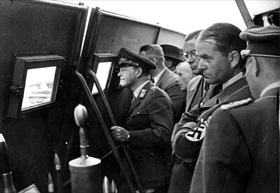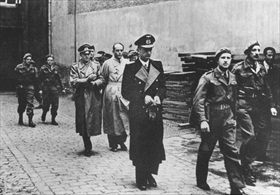ALBERT SPEER URGES WAR ECONOMY ON GERMANY
Posen, Occupied Poland · October 6, 1943
Despite Adolf Hitler’s Germany being engaged in a European and, after December 11, 1941, a global war, the Nazi leader (Fuehrer) had not directed his country’s full industrial might toward total war as had the leaders of his enemy states—the United States, Great Britain, and the Soviet Union. Hitler, to keep Nazi politicians and the wider populace from being inconvenienced by shortages of consumer products, put creature comforts ahead of the needs of his war machine, the Wehrmacht. It was the old argument of whether a nation can ill-afford guns (also tanks, planes, and other weapons of war) as well as butter or just one, not both.
On this date in 1943 in Posen (Poznań), German-occupied Poland, Albert Speer (pronounced “spare”), the Fuehrer’s Minister of Armaments and War Production, stunned an assembly of Nazi Party big-wigs when he stated that he intended to convert all factories producing for the German civilian market to war production. Having discussed his intentions beforehand with Reichsfuehrer-SS Heinrich Himmler, the second most powerful German leader after Hitler, Speer emphasized that he would brook no dissension. “I am prepared to apply the authority of the Reich Government at any cost,” he told the “Gold Pheasants,” as the national leadership of ambitious, greedy, and power-hungry toadies was derisively known. “From now on, districts that do not carry out within 2 weeks the measures I request will be dealt with firmly.”
The gifted former “Architect of the Reich”—he designed the enormous prewar Nuremberg Nazi Party Congress tribune and rally grounds as well as the new Reich Chancellery in Berlin—succeeded to his elevated cabinet position on February 8, 1942, despite knowing nothing about armaments production. (It didn’t hurt that Speer had a close personal relationship with Hitler; he was sometimes referred to as “Hitler’s unrequited love.”) According to the minutes of a conference at Wehrmacht High Command the following month, “It is only Speer’s word that counts nowadays. He can interfere in all departments. Already he overrides all departments.” Hitler diarist Joseph Goebbels wrote in June 1943, “Speer is still tops with the Fuehrer. He is truly a genius with organization.”
Near the end of the war Speer became the Nazis’ principal exploiter of forced labor, whose millions enabled German production of planes, tanks, and guns to exceed pre-1943 levels. Indeed, Speer’s achievement at allocating resources under the constant rain of Anglo-American bombers and the encroachment by land forces of the Red Army in the East has been credited with keeping the German Wehrmacht in the field and prolonging the war by at least a year. Sentenced to 20 years’ imprisonment for his role in the ruthless Nazi regime, Speer died in 1981 in London at age 76, ironically on the 42nd anniversary of the German invasion of Poland, the starting date for the outbreak of World War II in Europe.
Albert Speer: The Man Who Kept Germany Armed and the War Machine Running
 |  |
Left: On June 28, 1940, 2 weeks after the German Wehrmacht had occupied Paris almost without firing a shot, Hitler visited the French capital accompanied by “Architect of the Reich” Albert Speer (left) and sculptor Arno Breker, whom Hitler had named “official state sculptor” in 1937. A cameraman (lower right in photo) filmed the trio against the backdrop of the Eiffel Tower for German newsreel audiences.
![]()
Right: In June 1943 Hitler awarded Minister of Armaments and War Production Speer the Fritz Todt signet ring (enclosed in a silver box decorated with the portrait of deceased Dr. Fritz Todt) in recognition of Speer’s “unique achievements in the field of German technology.” The award of the ring was sponsored by the National Socialist Union for German Technology, which Speer headed.
 |  |
Left: Having convened a working meeting of the leading men of the German armaments industry, Armaments Minister Speer (right, with arms folded and swastika armband) and Luftwaffe Inspector General Field Marshal Erhard Milch (center in photo) stand behind protective shields during a weapons test at an airfield somewhere in the east of the Reich (probably in occupied Poland) in October 1943.
![]()
Right: May 23, 1945, arrest of leading members of the Flensburg Government, the short-lived administration of several weeks that attempted to rule Nazi Germany following Hitler’s suicide on April 30. Reich President Adm. Karl Doenitz (center, in dark long coat) is followed by Speer (bareheaded), and Gen. Alfred Jodl (left of Speer). All 3 men were transferred to the Allied military prison in Nuremberg in the German state of Bavaria and indicted as major war criminals at the International Military Tribunal that took place there (November 20, 1945, to October 1, 1946). Speer, who exercised direct control of the underground V‑2 rocket factory at Nordhausen-Dora among other slave-labor facilities, and Doenitz, who headed the Kriegsmarine, were given prison sentences of 10 and 20 years, respectively. Jodl, the Chief of the Operations Staff of the Armed Forces High Command (Oberkommando der Wehrmacht), was sentenced to death and hanged on October 16, 1945.
Albert Speer, Hitler’s Architect, Master Builder, and Minister of Armaments and War Production
![]()

 History buffs, there is good news! The Daily Chronicles of World War II is now available as an ebook for $4.99 on Amazon.com. Containing a year’s worth of dated entries from this website, the ebook brings the story of this tumultuous era to life in a compelling, authoritative, and succinct manner. Featuring inventive navigation aids, the ebook enables readers to instantly move forward or backward by month and date to different dated entries. Simple and elegant! Click
History buffs, there is good news! The Daily Chronicles of World War II is now available as an ebook for $4.99 on Amazon.com. Containing a year’s worth of dated entries from this website, the ebook brings the story of this tumultuous era to life in a compelling, authoritative, and succinct manner. Featuring inventive navigation aids, the ebook enables readers to instantly move forward or backward by month and date to different dated entries. Simple and elegant! Click 











